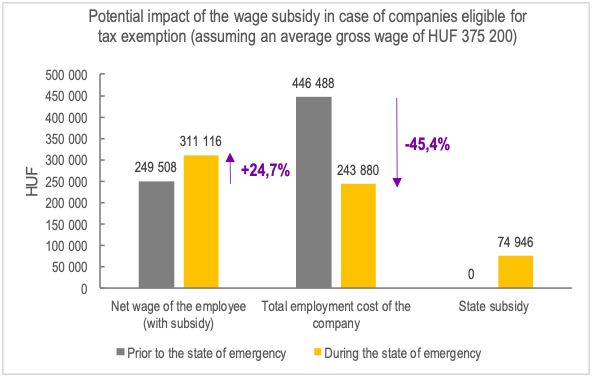Is the Hungarian wage subsidy enough to prevent mass layoffs?
EnglishIn the current article we will show what relief the keenly-anticipated wage subsidy might provide for the businesses.
As it has been emphasized by the government multiple times, the Hungarian wage subsidy scheme is based on the German „kurzarbeit” concept which proved efficient during the 2008 economic crisis. The introduced wage subsidy incentivizes companies to keep employing their workers in reduced time instead of mass layoffs. In return for maintaining the employment relationship, the government undertakes to complement the employees’ reduced (part-time) net wage. The government hopes that the wage subsidy will make the part-time employment more acceptable to the concerned employees.
According to the relevant Government Decree, those employees will be eligible for the wage subsidy whose working hours will be reduced by at least 30%, but not more than 50% compared to their original working hours as a result of the switch to part-time employment due to the coronavirus pandemic.
The (monthly) amount of the subsidy per employee is 70% of the net wage reduction (i.e., difference between the original net salary and the reduced part-time net salary) capped at HUF 74,946 per employee.
The government agency transfers the tax-free wage subsidy directly to the employee’s bank account subsequent to each subsidized month. Furthermore, the employee and the employer must agree on an „individual development time” in addition to the reduced working time for at least the duration of the subsidy. Individual development time means the exemption from work duties for the 30% of the working hours lost due to the reduced work time. The employer should pay a certain amount of compensation for the individual development time, however, the Decree does not specify its extent.
The maximum duration of the subsidy is three months. In case of timely application, the months of May-June-July can be covered by this grant.
The above scheme will fulfil the „three-player model” previously suggested by the Hungarian Chamber of Commerce and Industry. Pursuant to the three-player model, apart from the state, businesses (employers) and individuals (employees) should also share the burden of the coronavirus pandemic:
- Companies undertake to retain their workforce (at least in reduced time) despite the economic crisis caused by the coronavirus;
- Employees waive certain part of their wages (but in less extent than the reduction of work hours);
- The state takes on part of the burden by servicing a subsidy of max. HUF 74,946 to the employees.

As it can be seen on the above diagram, in case of a 50% reduction in working time, the net wage of the employee drops only by 5% due to the state subsidy, while the number of working hours falls by 35% (20 work hours and 6 hours of individual development time per week).
As a result of the part-time employment, the employment cost of the company decreases by 35% compared to the employment cost effective prior to the declaration of the state of emergency, while the government supports the maintenance of the given workplace by HUF 75 thousand on a monthly basis.

The effect of the wage subsidy is more prominent in case of those industries which have been granted tax exemption by the government as per the Government Decree introduced on 18 March (e.g. tourism, hospitality or entertainment):
while the net wage of the employees increases by almost 25%, the employment cost of the businesses decreases by 45% compared to the pre-COVID amount.
Although, the wage subsidy does not come for free: the participating companies are obliged to maintain the average statistical headcount (effective at the time of the application) during the subsidized period with an extension by one month. This commitment may pose a challenge in the current uncertain economic environment, in particular for the market players in sectors most affected by the crisis (tourism, hospitality, etc.). The related risk is enhanced by the fact that in case of violating the obligation of maintaining the average statistical headcount, the company will be required to make payments to the National Employment Fund – even though the employees are the ones who receive the subsidy directly from the government agency.
So, will the introduced wage subsidy be enough to prevent mass layoffs? The maximum monthly amount of the subsidy is highly debated by the market players.
Those large companies with sufficient reserves whose business operation is likely to recover – even if not at full capacity – within a matter of months (e.g. car manufacturers and their suppliers) might be incentivized by the wage subsidy to retain their employees.
It is possible that the subsidized part-time employment is cheaper than laying off the workforce and within couple of months recruit, engage and train new labor. However, most of the Hungarian SMEs probably does not have enough reserves to retain the whole workforce for several months regardless of the available subsidy on part-time employment.
The writer is senior tax adviser at EY
